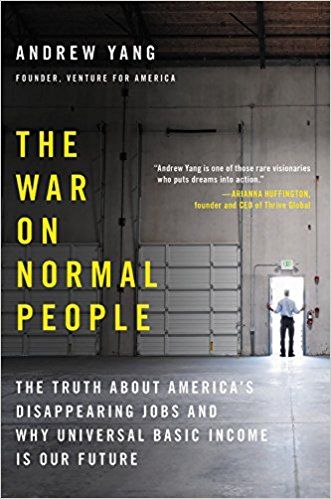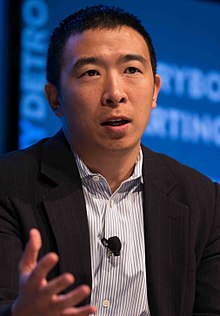Top Stories
The War on Normal People—A Review
Recognising that there is a problem is half the battle.

A review of The War on Normal People: The Truth About America’s Disappearing Jobs and Why Universal Basic Income is Our Future by Andrew Yang. Hachette Books (April 2018) 305 pages.

“I am writing from inside the tech bubble to let you know that we are coming for your jobs.”
So begins Andrew Yang’s book, The War on Normal People: The Truth About America’s Disappearing Jobs and Why Universal Basic Income is Our Future. Despite the tagline, this isn’t fundamentally a book about Universal Basic Income (UBI). It’s about the market, and our attitude towards it.
American society has been reorganising over the past few decades. Some business sectors have faded, while others have surged. Importantly, many of the surging sectors are concentrated in a few key regions. This has led to what Yang refers to as “six paths to six places,” meaning that the most qualified college graduates generally choose a career in one of six sectors and in one of six places: finance, consulting, law, technology, medicine, or academia in New York, San Francisco, Boston, Chicago, Los Angeles, or Washington, DC. All these sectors are highly knowledge-intensive.
The result has been an increasing stratification of American society. The most qualified people leave their hometowns to pursue a career in one of these sectors, while those who remain behind are generally forced into far less attractive sectors such as retail, transportation, and manufacturing. This has led to entirely different climates. People in the right sectors and regions experience a climate of abundance, whole those in the wrong sectors and regions experience a climate of scarcity. Income inequality has risen to historic levels.

Now, I suspect this trend is surprising to very few people. (Although some might be taken aback by its severity.) Social commentators have been talking about it for decades. But this is only the beginning of Yang’s story, which brings us to his quote at the beginning of the book. It isn’t simply the case that American society is separating into strata, Yang argues, but that the elites are consciously working to put the rest of society out of work.
The sectors where “normal” people tend to work—administration, retail, food service, transportation, and manufacturing—have high levels of repetitiveness and are highly susceptible to automation. Since competition in these sectors is quite fierce, companies are sooner or later forced to automate to keep up with their competition. Once a single competitor automates, the others must follow. In many cases, automation is not only cheaper, but also produces better products or services. The natural result is, as Yang relates through conversations he’s had with people in the tech industry, a race to make “normal” people redundant.
This is not science fiction, it’s already happening. Millions of jobs have been automated away in the manufacturing sector. Many are disappearing in the retail sector, partly due to in-store self-service and partly due to e-commerce. Next up is the transportation sector, as self-driving technology will soon replace millions of truck drivers. The food service and administration sectors are likewise vulnerable. Even many white-collar jobs will disappear. The Fed categorises 44 percent of all American jobs as routine, which makes them susceptible to automation. A White House report predicted that 83 percent of jobs where people make less than $20 an hour will be subject to automation or replacement.
The effects of automation are self-reinforcing. Once a mall loses its anchor store, it often goes into a death spiral, and many of the large chains with anchor stores are already in bankruptcy or close to it. Of America’s 1,300 malls, analysts predict that 400 will close in the next few years, and 650 more will struggle to stay in business. Similarly, millions of people work in diners and other places that service truck drivers on their trips. When trucks start driving themselves, these jobs will be lost as well. The disappearance of local white-collar jobs to automation in insurance, banking, journalism, and many other sectors will further drain money from local economies.
The consequences have already been severe. A large percentage of manufacturing workers laid off in recent years are now on disability, which has risen dramatically. In some areas, 20 percent of working-age adults are on disability. 59,000 Americans died of a drug overdose in 2016, up 19 percent from 2015, which was itself a record. For the first time, drug overdoses have surpassed car accidents as the leading cause of accidental death in the United States. Suicides are also way up. As a result, life expectancy has decreased for middle-aged white Americans, almost unheard of in a developed country for any group. Marriage rates have decreased dramatically for working-class people, and single parenthood rates have risen. All these things appear tied to economic pressures.
Especially troubling is the effect on young men. Yang reports that: “[a]s of last year, 22 percent of men between the ages of 21 and 30 with less than a bachelor’s degree reported not working at all in the previous year—up from only 9.5 percent in 2000.” Consequently, many more young men are living with their parents than in the past. This coincides with a heavy increase in time spent on video games, and many of them will be unable to enter the workforce later on and will be unable to lead productive and fulfilling lives. Men in 2016 made up only 43 percent of college graduates, and that figure will likely drop below 40 percent in the near future. One in six men of prime age (25-54), are unemployed or out of the workforce. Men seem to be especially reliant on a job as a core part of their identity, so they often become socially detached and nihilistic when unemployed or in dead-end jobs, leading to drug abuse, suicide, and other social dysfunction.
* * *
Given this trend, it’s not surprising that many non-elites feel a certain amount of animosity towards the elites. And as Yang demonstrates through several anecdotes, this animosity is not entirely unjustified. There really is a sense in which elites are working towards the immiseration of regular people by automating away their jobs. This is what Yang provocatively refers to as “the war on normal people.”
If it is a war though, it’s entirely one-sided. Elites go through top colleges together, start companies together, share knowledge through informal networks, and take on complementary jobs as software developers, financiers, consultants, and lawyers. New automations are effectively the products of a wealth of shared knowledge and co-operation. Non-elites, on the other hand, especially those who don’t go to college and live in declining communities, are almost entirely atomised. Union membership has declined significantly, as has participation in other social organisations. Many jobs are temporary. This means that workers have little recourse, or even warning, as their jobs disappear. The power differential between elites and non-elites could hardly be greater.

Yet, as Yang points out, most elites don’t actually want it this way. Studies show that even the wealthiest people are less content when there’s too much inequality in society, and many of Yang’s friends are reluctantly “buying bunkers and escape hatches just in case.” The real problem is ideological. America suffers from market fundamentalism, Yang argues, reflected in a veneration of the notion of meritocracy and an uncritical belief in simplistic economic theories.
This must change, Yang believes, and everyone has a stake in it, even the elites. He describes himself as an “ardent capitalist,” but believes that capitalism must evolve to the next stage. The market is a tool society should use to its advantage, not something it must be a slave to.
He proposes three solutions. First, a UBI of $1,000 a month for every U.S. citizen, paid for by a 10% value-added tax on all goods and services. Second, a new, secondary economy based on time rather than money. Third, a tougher and more vigilant government. These are all interesting suggestions, worthy of discussion. That said, the best part of Yang’s book in my opinion is his description of the problem, which he manages to do in simple and powerful terms. Recognising that there is a problem is half the battle.
For this reason, I think the people who would benefit most from the book are those who are beholden to the kind of market fundamentalism Yang describes. There’s a subset of political commentators and journalists, especially on the centre-right, who fit in that category. Yet a lot of these people are not actually that familiar with the modern economy. They’ll quote John Locke or Adam Smith but are unaware of much of the data Yang presents. Nor are they intimately aware of what’s actually going on in the tech sector, as Yang is.
(And historical contingencies aside, it’s not clear why conservatives should embrace market fundamentalism. Few things are more disruptive than capitalism, and as Yang argues impoverished communities become more atomised as families disintegrate and dysfunctional behaviour increases.)
One can argue that the political centre has collapsed over the past few years precisely because white working-class people have realised that market fundamentalism is harming them. Yang argued as much on a recent podcast with Sam Harris when he said that “the reason why Trump is our president today is because we automated away four million manufacturing jobs in the swing states.”
But Donald Trump’s version of market criticism is not the answer. Import tariffs won’t address the problem, because most of the lost jobs are due to automation, not to sending them abroad. And even the minority of lost jobs that have been sent abroad will be automated away eventually. (Yang describes how a call centre in the Philippines is gradually removing humans from their processes.) All tariffs do is harm the economy by making trade more difficult.
What I like about Yang’s book is that he manages to create a sense that people are in this together. He does point out that blacks and Hispanics earn significantly less on average than whites and Asians and have significantly less wealth—facts he says “make my head and heart hurt”—but he also emphasises how working-class whites are increasingly suffering from this. Likewise, he mentions that women on average have lower income and wealth than men, but he also describes how more and more men are becoming detached from the education system and job market. Even elites have a stake in this, in his view.
That said, Yang’s thesis should not be taken uncritically. He addresses some objections to it in the book and on Harris’s podcast, but this is far from settled science. Many people argue that the market will find a way to produce new jobs, as it did after the industrial revolution. But Yang’s book offers both data and anecdotes in support of a thesis worth taking seriously.
Finally, let me say that this book is entirely focussed on the U.S., so I wouldn’t recommend it to most non-Americans. However, the general issues it raises are relevant for every Western country. In fact, one could argue that the effects could be even more severe, since many of these countries might end up with the worst of both worlds: a bottom segment without the top. The extent to which many Europeans have replaced local media and entertainment with Facebook, YouTube, and Netflix—all located in California—demonstrates how this could eventually play out internationally.






